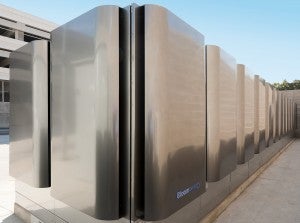 Throughout 2012, EDF’s Energy Innovation Series will highlight more than 20 innovations across a broad range of energy categories, including smart grid and renewable energy technologies, energy efficiency financing, and progressive utilities, to name a few. This series will demonstrate that cost-effective, clean energy solutions are available now and imperative to lowering our dependence on fossil fuels.
Throughout 2012, EDF’s Energy Innovation Series will highlight more than 20 innovations across a broad range of energy categories, including smart grid and renewable energy technologies, energy efficiency financing, and progressive utilities, to name a few. This series will demonstrate that cost-effective, clean energy solutions are available now and imperative to lowering our dependence on fossil fuels.
For more information on this featured innovation, please view this video on Bloom Energy’s fuel cell technology.
California-based Bloom Energy is developing a different approach to power generation that has already had a profound impact on the way electricity is produced around the world.
Bloom Energy’s technology relies on fuel cells, which use an electrochemical process in which oxygen and fuel (natural gas or biogas) react to produce small amounts of electricity. When these fuel cells are stacked upon each other and arranged into large modules called Bloom Energy Servers™ or “Boxes,” they produce up to 200 kW of on-site power. This is enough power to meet the baseload needs of the average office building or 160 average homes.
Furthermore, this approach has the potential to reduce customers’ CO2 emissions by “40%-100% compared to the U.S. grid (depending on their fuel choice) and virtually eliminate all SOx, NOx, and other harmful smog forming particulate emissions.” It also enables the possibility of affordable on-site, user-owned power generation that is as constant and reliable as a utility and provides an attractive economic payback for customers.
This kind of technology is a win-win economically and environmentally; one from which all sectors stand to benefit. The Bloom Energy Server also makes the micro-generation concept feasible. Imagine subdivisions, apartment complexes or neighborhoods with their own carbon-free (if powered by renewables), mini power plants.
Founded in 2001, Bloom Energy sold its first Bloom Box to Google and can trace its roots to the NASA Mars space program. In the last few years, the company has lined up an impressive list of name-brand customers, including eBay, Walmart, Coca-Cola and FedEx and is rumored, according to GigaOm and others, to be “the supplier behind Apple’s planned massive 5 megawatt (MW) fuel cell farm to be built at its data center in Maiden, North Carolina.” If built, this would be the nation’s biggest non-utility fuel cell installation.
In the U.S., much of the attention the Bloom Box has generated has focused on these large corporate customers. But the on-site generation concept could make its biggest impact in developing nations like India and China, where small communities and villages don’t have an electric infrastructure and new energy sources are in high demand.
The Bloom Box also has the potential to address problems here at home, with reliability concerns facing electric grids throughout the country. In Texas, where the Electric Reliability Council of Texas (ERCOT) struggles with how to add new capacity to meet growing peak demands and reduce water dependency at the same time, the Bloom Box offers an approach that can provide power at well below the peak prices paid for electricity during last year’s record drought.
To learn more about this topic, please view this post by Nobile Profit.
Update: eBay announced on June 21, 2012, that it will be using Bloom Energy fuel cell technology to construct a large-scale project at its data center in Utah. The proposed 30 fuel cells (the largest non-utility fuel cell installation) will run on biogas and will make their data center independent of the electricity grid.











2 Comments
None of what you say is about Bloom and what they have done is really “new”.
UTC and FuelCell Energy have had fuel cells in the field for over 20 years.
In the case of UTC they have actually backed up computer systems such as Verizon and FirstNational bank of Omaha and OCMBoces.
I have been personally involved with operating fuel cells,UTC’s ,on actual landfill gas, 3, and gas from an anaerobic digestor, about 15.
Bloom does not actually operate on renewable gases but operates on what is called “redirected” renewable ie a renewable gas is cleaned up put into a natural gas ie methane pipeline and distributed to customers.Bloom takes a portion of that gas which is now mostly methane and uses it.All other customers on that pipeline operate on the same gas as does Bloom ,which is basically “common” pipeline gas.
Bloom pays money to the original producer who cleans up the renewable and puts it into the pipeline. Quite different than actually operating on the renewables above
John, you should look into what AFC Energy is doing ! http://www.afcenergy.com !